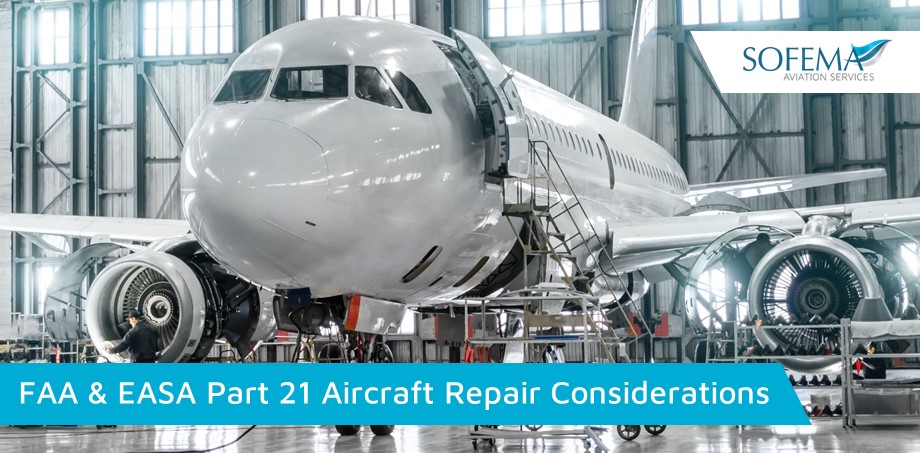FAA & EASA Part 21 Aircraft Repair Considerations – Review by Sofema Aviation Services (SAS) www.sassofia.com
Introduction
Damage to aircraft structure typically creates operational interruptions which may have significant and costly implications. The restoration to an airworthy condition takes on an important and of course needs to be certified before the next revenue flight.
Please see This Link to review in detail the following Aspects which are highlighted below.
Concerning Instructions for Continuing Airworthiness (ICA)
ICA results from the certification program are linked to the Type Certificate (TC) and its modifications. Such requirements related to the maintenance of continuing airworthiness are compulsory according to the applicable airworthiness codes.
Note: Requirements which are identified as Airworthiness Limitations “Section” (ALS) are mandatory and must be complied with in full.
The Type Certificate Holder is required to support the CAW proves by:
- Investigating and analysing failures, malfunctions, and defects linked to its products.
- When an Airworthiness Directive (AD) is issued against the unsafe condition:
o To propose the appropriate corrective action,
o To make them available to all known operators’ accomplishment instructions.
FAA and EASA Repair Design Data Approval Process
Note 1: Airbus
- Airbus supports the approval of repairs’ actions or damage allowance with a ‘Repair design Approval Sheet’ (RAS) In 2003 Airbus was approved to certify major repair design. From 2004 the approvals are now issued under an EASA DOA.
Note 2: Boeing
In the case of Boeing Aircraft, the repair having been designed in accordance with Part 21 Design Standards or designed by Boeing the repair is approved by the issue of FAA 8100-9 FAA form approving the repair.
The difference between Airbus and Boeing is that the FAA form 8100-9 is issued under Organization Designation Authorization (ODA) which is issued to a company (in this case Boeing). The company then decides who to appoint as the individual members. A DER cannot sign the 8100-9 form unless they are also an ODA appointed designee but the DER still uses the 8110-3 form to show compliance to the FARs. Either way, both forms are considered FAA “approved” data whereas the RDAS is issued under DOA privilege.
Acceptance of Design Data – Bilateral Acceptance
Acceptance of Design Data Used in Support of Repairs Design data used in support of repairs must be approved or accepted, as appropriate, by the exporting Authority/State of Design (SoD).
FAA Acceptance of EASA Repair Design Data
- The FAA shall accept EASA approved design data produced under EASA Part 21 Subpart M used in support of major or minor repairs regardless of the SoD of the product, part, or article, if:
o The FAA has certificated/validated the product or article;
o EASA is acting on behalf of the SoD for the repair design data;
o EASA repair design data approval is substantiated via a repair design approval letter or a repair design approval issued under a DOA.
EASA Acceptance of FAA Repair Design Data
- EASA shall accept data used in support of major repairs regardless of the SoD of the product, part or article, if: EASA has certificated/validated the product or article;
- The FAA is the Authority of the SoD for the repair design data; and
- The FAA repair design data approval is substantiated via
o An FAA letter,
o FAA Form 8110-3,
o FAA Form 8100-9,
o FAA Form 337 or a signed cover page of a repair specification.
Restoration of Continuing Airworthiness through Compliance with the Repair Design
A damaged aircraft shall be assessed also from an airworthiness standpoint before the return to service and to show evidence of an acceptable level of safety.
This assessment requires the organisations to inspect the damaged aircraft, design and approve the repair, embody the repair and inspect the repair according to the repair approval.
Basically, the tasks of an organisation designing a repair are similar to a modification to a TC, such as to draw/design the repair, show compliance to the requirements and obtain, or to approve, the repair design.
Next Steps
We are pleased to provide Regulatory Compliant & Vocational Training as Classroom, Webinar, or Online Courses. If you want to know more about our services, please see www.sassofia.com or www.sofemaonline.com or email us at team@sassofia.com
Tags:
Aircraft Repair Considerations, EASA Acceptance, Repair Design Data, SoD, State of Design, ODA, Organization Designation Authorization, Boeing, Airbus, Airworthiness Limitations Section, ICA, Instructions for Continuing Airworthiness, AD, TC, Type Certificate, SAS blogs, CAW, easa part 21, ALS, FAA, EASA, airworthiness directive, Aircraft Maintenance




